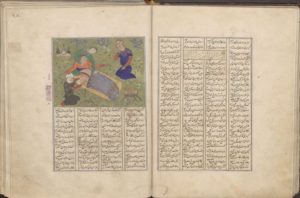THE BIRTH OF RUSTAM
“THE BIRTH OF RUSTAM”
First half of the XV century. Herat school.
The miniature is executed for the “Shahnameh” of Abu’l-Qasim Ferdowsi.
This work is a facsimile copy of the miniature from the manuscript kept in the Museum of Turkish and Islamic Art in Turkiye.

The masterpiece of Persian literature, “Shahnameh” (“The Book of Kings”), was written by the Persian poet Abu’l-Qasim Ferdowsi in the early XI century. Created within 35 years (976-1011), the poem consists of almost sixty thousand couplets (bayts), its volume is twice as much as “The Iliad” and “The Odyssey” combined. Ferdowsi included in the poem a thousand couplets written by his predecessor Dakiki, who died in his youth and couldn’t manage to complete his work. Covering the lives of fifty monarchs the “Shahnameh” is conventionally divided into three parts – mythological, heroic and historical and includes the history of Iran from ancient times to the penetration of Islam in the VII century. The poem is written entirely in Persian at a time when Arabic was the primary language of science and literature. Thus, Ferdowsi contributed to the flourishing and spread of the Persian language in the world.
A native of Sistan, the hero Rustam is one of the most beloved figures in the “Shahnameh” epic. He was called up for the military service at the Shah Kay-Kavus palace and distinguished himself by complete loyalty to the motherland and king.
Ferdowsi gives the image of Rustam one of the important places in his poem, gifting his personality the best qualities of a human being. The uncompromising will, strength and courage of the hero Rustam can be judged by the description given to him at birth:
None had seen a thing so strange.
The babe was like a lion,
A hero tall and fair to look upon.
According to the epic, Rudaba, the mother of Rustam could not give birth to such a big child on her own. Therefore, her husband Zal calls for help the magical bird Simurgh, who orders to summon the clairvoyant, and in the meantime intoxicate the woman in labor with wine. The healer, as Simurgh said, would cut an incision in the Rudaba’s side, extract the baby, and then sew up the womb of the “moon-faced beauty”. In order for the wound to heal faster, Simurgh suggested Zal to apply a healing mixture to Rudaba’s belly and then rub the scar with a magic feather that Simurgh had pulled out of her wing.
In the center of the miniature, the scene of birth of the hero Rustam is depicted. The healer pulls a large baby out of Rudaba’s side. Exhausted from agony and suffering, the intoxicated Princess Rudaba lies with her arms spread out to the sides that adds truth and realism to the miniature scene.
In the upper right part of the composition sits the gray-haired Zal, worried about his wife. He is portrayed in a blue robe and with a crown on his head.
In the left part of the miniature, next to the woman in labor, the healer extracts the baby from Rudaba’s abdomen by Caesarian section.
Above Rudaba’s head, the princess’s mother Sindokht is portrayed supporting her daughter.
In the bottom right corner, there is a fire burning in the brazier, and a dagger lies next to the healer. The magical feather of the Simurgh bird is depicted at the bottom of the miniature. In the upper left corner, there are three vessels on a small table.
At the top of the miniature, blue clouds are depicted. The background of the composition is in olive color.
The left page of the book is half consists of the calligraphic text, and half of the illustration.
КК-623. INV–175